Im retyping a processing script into python so i can use it in a gimp-python script. Im having trouble with strokeWeight(0.3), which means a thickness of less than 1 pixel.
I have followed suggestions as to blend the rgb colors with alpha but that didnt work. It would seem that processing is doing something else. I have tried to look up the strokeWeight function in the processing sourcecode but i couldnt really make sense of it. I have also tried to compare color values with an strokeWeight of 1 against those with an strokeWeight of 0.3 but i also couldnt make sense of it.
Does anybody know what processing does when setting strokeWeight to 0.3, how would one simulate this?
The script i am using is:
String filename = "image2";
String fileext = ".jpg";
String foldername = "./";
// run, after 30 iterations result will be saved automatically
// or press SPACE
int max_display_size = 800; // viewing window size (regardless image size)
/////////////////////////////////////
int n=2000;
float [] cx=new float[n];
float [] cy=new float[n];
PImage img;
int len;
// working buffer
PGraphics buffer;
String sessionid;
void setup() {
sessionid = hex((int)random(0xffff),4);
img = loadImage(foldername+filename+fileext);
buffer = createGraphics(img.width, img.height);
buffer.beginDraw();
//buffer.noFill();
//buffer.smooth(8);
//buffer.strokeWeight(1);
buffer.strokeWeight(0.3);
buffer.background(0);
buffer.endDraw();
size(300,300);
len = (img.width<img.height?img.width:img.height)/6;
background(0);
for (int i=0; i<n; i++) {
cx[i] = i; // changed to a none random number for testing
cy[i] = i;
//for (int i=0;i<n;i++) {
// cx[i]=random(img.width);
// cy[i]=random(img.height);
}
}
int tick = 0;
void draw() {
buffer.beginDraw();
for (int i=1;i<n;i++) {
color c = img.get((int)cx[i], (int)cy[i]);
buffer.stroke(c);
buffer.point(cx[i], cy[i]);
// you can choose channels: red(c), blue(c), green(c), hue(c), saturation(c) or brightness(c)
cy[i]+=sin(map(hue(c),0,255,0,TWO_PI));
cx[i]+=cos(map(hue(c),0,255,0,TWO_PI));
}
if (frameCount>len) {
frameCount=0;
println("iteration: " + tick++);
//for (int i=0;i<n;i++) {
// cx[i]=random(img.width);
// cy[i]=random(img.height);
for (int i=0; i<n; i++) {
cx[i] = i; // changed to a none random number for testing
cy[i] = i;
}
}
buffer.endDraw();
if(tick == 30) keyPressed();
image(buffer,0,0,width,height);
}
void keyPressed() {
buffer.save(foldername + filename + "/res_" + sessionid + hex((int)random(0xffff),4)+"_"+filename+fileext);
println("image saved");
}
Here are some test results, (scaled 200%):
(it should be noted that this is a fairly straight line for comparison purpose. The actual code uses random coordinates.)



